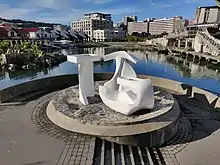Tanya Ashken
Tanya Ashken (born 1939 in London, England) is a New Zealand silversmith and sculptor.[1] She was one of a number of European-trained jewellers who came to New Zealand in the 1960s and transformed contemporary jewellery in that country, including Jens Hoyer Hansen, Kobi Bosshard and Gunter Taemmler.[2]
Tanya Ashken | |
|---|---|
| Born | Tanya Ashken 1939 London, England |
| Known for | Sculptor, silversmith |
| Notable work | Albatross, Frank Kitts Park, Wellington (1986) |
Ashken attended the Central School of Arts and Crafts in London, where she was awarded a diploma in silversmithing in 1960, and also studied sculpture at the Atelier de Del Debbio in Paris the following year.[3]: 157 [4] She began making jewellery in semi-precious materials in 1962.[1] She does not draw a distinction between her jewellery and her sculpture: “her jewellery is small sculpture that can be worn.”[4]
Ashken married New Zealand artist John Drawbridge (1930–2005) in 1960[5] and emigrated to New Zealand in 1963.[6] In 1966 her work was included in Recent New Zealand Sculpture at the Auckland City Art Gallery.[7]

In 1967 Ashken was the second artist to be awarded the Frances Hodgkins Fellowship, an opportunity for her to spend a year in Dunedin developing ideas for large sculptures.[3]: 157 After this Ashken attracted a number of major commissions, including Seabird V (1974) for the New Zealand High Commission in Canberra and her best-known work, the water sculpture Albatross (1986) in Frank Kitts Park, Wellington.[3]: 157 [8] This was a first commission for the Wellington Sculpture Trust. Hone Tuwhare wrote a poem to mark the occasion.[9] Ashken said she got the idea for the Albatross sculpture while walking along a beach in Island Bay in 1979 and seeing waves crashing around rocks.[10] She initially submitted Albatross to the Aotea Square Water Sculpture competition and was shortlisted as one of six finalists.[11] In December 1979 the commission was awarded to Terry Stringer's Mountain Fountain.[12]
Art historian Anne Kirker describes Ashken's sculpture as “graceful organic forms articulated by the play of natural light”, and notes the evocation of “weathered stone or the graceful movements of seabirds – familiar components of her Island Bay home in Wellington“.[3]: 158
References
- Cape, Peter (1969). Artists and Craftsmen in New Zealand. Auckland, London: Collins. pp. 89–94.
- Skinner, Damian (2012). Kobi Bosshard : goldsmith. Albany, Auckland: David Bateman. p. 9. ISBN 978-1869538217.
- Kirker, Anne (1993). New Zealand Women Artists: A Survey of 150 Years (2nd ed.). Tortola, B.V.I.: Craftsman House. ISBN 9768097302.
- Skinner, Damian; Murray, Kevin (2014). Place and Adornment: A history of contemporary jewellery in Australia and New Zealand. Honolulu: University of Hawai'i. p. 59. ISBN 9781454702771.
- Foreman, Lewis (11 August 2005). "John Drawbridge". The Independent. Independent Print Limited. Retrieved 2 December 2014.
- Blumhardt, Doreen; Brake, Brian (1981). Craft New Zealand: The art of the craftsman. Auckland: A.H. & A.W. Reed. p. 279. ISBN 0-589-01343-2. Archived from the original on 30 November 2014.
- Recent New Zealand Sculpture (PDF). Auckland: Auckland City Art Gallery. 1966. Archived from the original (PDF) on 23 September 2015. Retrieved 22 December 2014.
- Harper, Jenny; Lister, Aaron, eds. (2007). Wellington: A City for Sculpture. Victoria University Press. pp. 35–37. ISBN 9780864735706. Retrieved 1 December 2014.
- "Tanya Ashken: Albatross". Wellington Sculpture Trust. Archived from the original on 17 September 2014. Retrieved 6 December 2014.
- Johnstone, Philip (14 August 1984). "Sculpture for harbourside". The Dominion. Retrieved 16 March 2021 – via Wellington City Council Archives Online website.
- Little, Paul (Autumn 1980). "The Aotea Square Water Sculpture". Art New Zealand (15). Archived from the original on 20 January 2023.
- "Spectacle for Aotea Square". Auckland Star. 5 December 1979. p. 3.